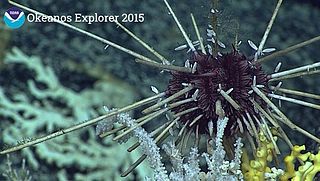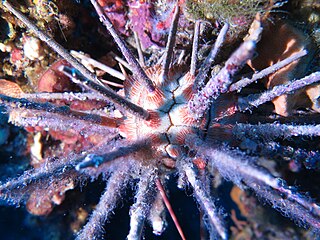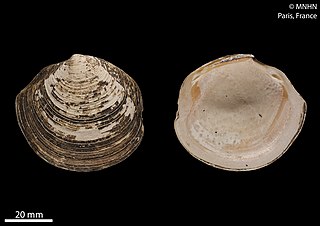
Echinarachnius parma, the common sand dollar, is a species of sand dollar native to the Northern Hemisphere.

The Diadematidae are a family of sea urchins. Their tests are either rigid or flexible and their spines are long and hollow.

Coelopleurus is an extant genus of echinoids with fossil records dating back to the Eocene, with remains found in Europe and North America.
Aplomya is a genus of flies in the family Tachinidae.

Holopneustes is a genus of sea urchins, belonging to the family Temnopleuridae.

Cidaridae is a family of sea urchins in the order Cidaroida.

Lovenia is a genus of sea urchin that is the sister taxon to Breynia and Echinocardium.

Clypeaster, common name "cake urchins" or "sea biscuits", is a genus of echinoderms belonging to the family Clypeasteridae.

Eucidaris is a genus of cidaroid sea urchins known as slate pencil urchins. They are characterised by a moderately thick test, a usually monocyclic apical disc, perforate and non-crenulate tubercles and nearly straight ambulacra with horizontal pore pairs. The primary spines are few and widely spaced, stout with blunt flat tips and beaded ornamentation and the secondary spines are short and apressed. They originated in the Miocene and extant members of the genus are found in the tropical Indo-Pacific Ocean, East Pacific, Atlantic Ocean and Caribbean Sea.

Toxopneustes maculatus is a rare species of sea urchin found in the Indo-West Pacific.

Histocidaris is a genus of sea urchins in the family Histocidaridae. Some species are known from the fossil record.

Amblypneustes is a genus of sea urchins, belonging to the family Temnopleuridae.

The pourtalesiids (Pourtalesiidae) are a family of irregular sea urchins that live in the deep sea. They are secondarily bilateral-symmetrical and like other representatives of the taxon Holasteroida they lack the lantern of Aristotle, which is typical for many other sea urchins. The genus Pourtalesia was named after Louis-François de Pourtalès who first collected these animals while dredging at a depth of 600 m. The family is known already from the Upper Cretaceous (Maastrichtian) and is distributed worldwide.

Goniocidaris is a genus of sea urchins (Echinoidea) in the family Cidaridae and typical of the subfamily Goniocidarinae. Extant species are mostly found in Indo-Pacific seas, often living at depth.
Schizasteridae is a family of echinoderms belonging to the order Spatangoida.

Stylocidaris is a genus of echinoderms belonging to the family Cidaridae.

Phacoides is a genus of bivalves belonging to the family Lucinidae.

Euryalidae is a family of echinoderms belonging to the order Euryalida.
Brissopsis is a genus of echinoderms belonging to the family Brissidae.

Microcyphus is a genera of echinoderms belonging to the order Temnopleuridae.


















